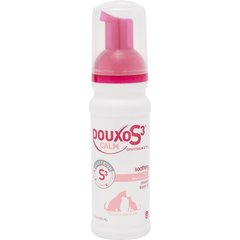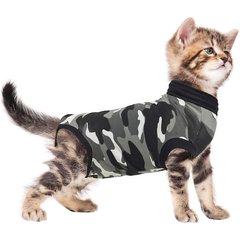Oriental Shorthair
Adobe Stock/Julia Vadi
Siamese cats are beloved in the cat community. But some cat enthusiasts wanted Siamese cats with coats just as vibrant as their personalities. And so the Siamese hybrid—the Oriental Shorthair cat—was born.
Coming in every hue and color combination possible, the Oriental Shorthair is a lively breed that treasures human companionship. They’re slender, with comically large ears and sweet, almond-shaped eyes.
Caring for an Oriental Shorthair
An Oriental cat won’t allow you to ignore them. In fact, if they’re feeling slighted, they’re sure to let you know with a vocalization that sounds more like a little goose honk than a cat meow—earning them the nickname “honking cat!”
They’re shadowlike and inquisitive, which means there’s no lack of entertainment or mischief when an Oriental cat is in the house. But at the end of an interactive day, the Oriental holds their own as one of the most affectionate cat breeds around.
Shop for Your Breed
- Douxo S3 CALM Soothing Itchy, Hydrated Skin Dog & Cat Mousse, 5.1-fl oz bottle$28.82Chewy Price
- Litter-Robot 4 with Step & Core Accessories Kit Cat Litter Box, Black$799.00Chewy Price
- Purina Pro Plan Veterinary Diets Crunchy Bites Crunchy Cat Treats, 1.8-oz bag$6.99Chewy Price
- Suitical Recovery Suit for Cats, Black Camo, X-Small$30.95Chewy Price
Oriental Shorthair Health Issues
The Oriental Shorthair is generally a healthy cat, averaging a 12–15-year lifespan. However, the breed is known for a few serious conditions, which is why purchasing pet insurance for your Oriental Shorthair kitten might be worth consideration.
Amyloidosis
Amyloidosis is the abnormal deposition of a fibrous protein called amyloid. It can occur in almost any tissue or organ, but Oriental Shorthair and Siamese cats are the breeds most predisposed to hepatic amyloidosis—or protein deposits in the liver. Unfortunately, the condition can lead to organ failure and death. According to a study published in The Veterinary Journal, cats with amyloidosis typically show signs of illness anywhere from 1–7 years of age.
To test for amyloidosis, your veterinarian will likely complete a series of urine, blood tests, and an ultrasound of the abdomen. After careful consideration of symptoms such as sudden lack of energy, loss of appetite, vomiting, or swelling of the belly, in addition to changes on the ultrasound, a diagnosis of amyloidosis can be made.
Pica
According to a study published in the Journal of Veterinary Behavior, Oriental cat breeds are prone to pica: the chewing, suckling, or consumption of non-food items. Pica increases a cat’s risk of poisoning and intestinal obstructions, which can be life-threatening. If your cat eats something inappropriate or stops eating their regular meals, speak with your veterinarian.
Hereditary Retinal Degeneration
Although more commonly reported in Abyssinian and Somali cats, the Oriental Shorthair and other Siamese-related breeds may be susceptible to genetic retinal degeneration. Typically, signs of the condition begin to appear in cats 1 or 2 years old, starting with night blindness and eventually leading to complete vision loss.
There is currently no cure for this condition. Nevertheless, cats without vision can still lead satisfying lives with special consideration and care. Responsible Oriental cat breeders will genetically test parents for the gene.
What To Feed an Oriental Shorthair
Oriental Shorthairs don’t require a special diet outside of a quality commercial diet meeting the Association of American Feed Control Officials (AAFCO) nutritional recommendations. However, the following tips will help keep your cat satisfied and healthy.
How To Feed an Oriental Shorthair
To maintain their slender figure, it’s not recommended to free-feed Oriental Shorthair cats. Rather than leaving food for all-day nibbling, consider feeding your cat several small meals a day. You can also engage their natural instincts with food puzzles or foraging activities at meal or snack times.
Ensure your cat gets the right nutrients they need, no matter how you choose to serve their meals. Oriental Shorthair kittens require food for growth or all life stages, while adult cats should eat an adult maintenance food unless they have a health concern that indicates a special diet is needed. When they get older, check with your veterinarian if a senior cat food diet is right for them.
How Much Should You Feed an Oriental Shorthair?
The number of calories your cat should eat daily depends on their age, lifestyle, and overall health. Feeding charts on the back of cat food bags or cans may be used as guides. However, your veterinarian is the best resource for determining your cat’s appropriate portion sizes.
Because rewards are an important part of bonding and training, high-quality treats can make up about 10% of your cat’s daily calories. Greenies dental treats and Vital Essentials Minnows are both high-value and nutritious treats for cats.
Nutritional Tips for Oriental Shorthairs
Cat food with an AAFCO nutritional adequacy statement means it’s complete and balanced, meeting your cat’s essential needs. Additional vitamins or supplements aren’t necessary to add to your cat’s food unless your veterinarian recommends them.
Behavior and Training Tips for Oriental Shorthairs
Oriental Shorthair Personality and Temperament
The Oriental cat doesn’t hesitate to start a conversation or insert themselves as the center of attention. They need frequent affection and entertainment, and can come off as grumpy when they feel they’re being slighted. But when lavished with love, Oriental cats reciprocate it tenfold.
Due to their highly socially personalities, Oriental Shorthairs can make wonderful additions for multi-pet households. As with any cat, introductions to dogs, other cats, and kids should be done slowly and with care.
An Oriental Shorthair won’t allow you to ignore them. In fact, if they’re feeling slighted, they’re sure to let you know with a vocalization that sounds more like a little goose honk than a cat meow.
Oriental Shorthair Behavior
While their behavior is easily mistaken for mischief, Oriental Shorthairs are highly intelligent and curious. Often, they can be found exploring new things or investigating their surroundings. Therefore, adopting an Oriental Shorthair means making time for interactive play sessions and training.
They love following their humans around the house—that is, when they’re not busy exploring anything that sparks their curiosity. Generally, they’re known to form strong bonds with their human companions and tend to stay close beside them. After a stimulating day, it’s not unlike an Oriental Shorthair to curl up in their human’s bed.
Oriental Shorthair Training
Cats can learn tricks, too! And because Oriental Shorthairs are athletic, intelligent, and form strong attachments with their caretakers, they’re ideal candidates for learning skills and tricks. Like all companion animals, they learn best with positive reinforcement training.
Fun Activities for Oriental Shorthairs
-
Clicker training
-
Puzzle feeders and snuffle mats
-
Bird watching
-
Cuddles, petting, and brushing
-
Being around people or other pets
Oriental Shorthair Grooming Guide
Coming in over 300 colors and patterns, the most popular of these include black, pure white, chestnut, and blue, and striking solid, bicolor, and tabby patterns. Here are some tips on how to keep that coat as bright as their character.
Skin Care
While they don’t require any special bathing or skin care, schedule a checkup with your veterinarian if you notice your cat is overgrooming, itching, or otherwise has skin irritation.
Coat Care
Oriental Shorthair cats have short, sleek coats that require minimal grooming. While a top pick for people with allergies, brushing your Oriental Shorthair weekly will minimize any shedding.
Eye Care
Oriental Shorthair cats have wedge-shaped faces, an especially long nose, and almond-shaped eyes perched above dramatic cheekbones.
These bold facial features don’t require extra work from human caretakers—as long as you routinely check your kitty for any abnormal eye discharge that might warrant a trip to the veterinarian. Additionally, if you recognize any signs of vision loss, such as bumping into objects, that also should be followed by a chat with your veterinarian.
Ear Care
The large, perky ears of an Oriental Shorthair don’t require special care. However, at the first sign of abnormal ear discharge, dark specks that look like coffee grounds (mites), or a foul smell from the ears, schedule a checkup with your veterinarian.
Considerations for Pet Parents
The Oriental Shorthair cat is a Siamese hybrid with a coat as vibrant as their personality. They are affectionate, intelligent, and curious cats that require a lot of attention and stimulation. When preparing to bring an Oriental Shorthair home, consider providing interactive toys, food puzzles, window perches, and cat trees.
You’ll also want to keep house plants and small objects such as hair ties and string out of reach, since Oriental Shorthairs may be prone to eating them. All in all, they’re a healthy breed. However, like all purebred cats, precautions should be taken when purchasing an Oriental Shorthair from a reputable breeder, such as ensuring both parents have been genetically tested for heredity diseases.
Oriental Shorthair FAQs
How much do Oriental Shorthair cats cost?
The Oriental Shorthair price varies, and kittens from a reputable breeder can cost $600–$1,500 depending on location, age, and pedigree.
Are Oriental Shorthair cats loud?
Yes, Oriental Shorthair cats are known to make a variety of vocalizations, from meowing, trilling, and chirping to their signature “honk.”
Do Oriental Shorthair cats make good pets?
Oriental Shorthair cats make excellent pets for those seeking an energetic cat who loves to cuddle. Oriental Shorthair pet parents should have ample time to socialize and play with their cat daily, as boredom can result in destructive or unwanted behaviors.
Are Oriental Shorthair cats hypoallergenic?
Because they have a short, sleek coat, Oriental Shorthair cats may be recommended for those with allergies to cats. However, no cat is truly hypoallergenic, so chat with your doctor before bringing home any kitten.




